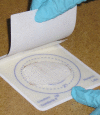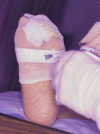Maggot therapy takes us back to the future of wound care: new and improved maggot therapy for the 21st century
- PMID: 20144365
- PMCID: PMC2771513
- DOI: 10.1177/193229680900300215
Maggot therapy takes us back to the future of wound care: new and improved maggot therapy for the 21st century
Abstract
In the 21st century, eighty years after William Baer presented his groundbreaking work treating bone and soft tissue infections with live maggots, thousands of therapists around the globe have rediscovered the benefits of maggot therapy. The renaissance in maggot therapy is due in large part to recent technological advancements that have solved or minimized many of the treatment's earlier drawbacks: the need for reliable access to this perishable medical device, simplified application, and low-cost production. Modern dressing materials have simplified the procedure and minimized the risk of escaping maggots. The establishment of dozens of laboratories throughout the world, along with access to overnight courier services in many regions, has made medicinal maggots readily available to millions of people in need. Studies show that fears of patient nonacceptance are unfounded. The medical literature is rapidly growing with scientific evidence demonstrating the efficacy and safety of maggot therapy for a variety of problematic wounds. This article examines how these and other technologies are optimizing the study and application of maggot therapy for wound care.
(c) 2009 Diabetes Technology Society.
Figures



Similar articles
-
Advantages of Maggot Debridement Therapy for Chronic Wounds: A Bibliographic Review.Adv Skin Wound Care. 2020 Oct;33(10):515-525. doi: 10.1097/01.ASW.0000695776.26946.68. Adv Skin Wound Care. 2020. PMID: 32941225 Review.
-
Maggot débridement therapy in outpatients.Arch Phys Med Rehabil. 2001 Sep;82(9):1226-9. doi: 10.1053/apmr.2001.24300. Arch Phys Med Rehabil. 2001. PMID: 11552195
-
A new dressing design for use with maggot therapy.Plast Reconstr Surg. 1997 Aug;100(2):451-6. doi: 10.1097/00006534-199708000-00029. Plast Reconstr Surg. 1997. PMID: 9252615
-
Maggot Therapy for Wound Care in Austere Environments.J Spec Oper Med. 2017 Summer;17(2):154-162. doi: 10.55460/DLAA-2TUT. J Spec Oper Med. 2017. PMID: 28599051
-
Increasing the options for management of large and complex chronic wounds with a scalable, closed-system dressing for maggot therapy.J Burn Care Res. 2012 May-Jun;33(3):e169-75. doi: 10.1097/BCR.0b013e318233570d. J Burn Care Res. 2012. PMID: 21983646 Review.
Cited by
-
Bioconversion of food waste by Chrysomya megacephala (Diptera: Calliphoridae) larvae: Potential for sustainable waste management and antimicrobial applications.PLoS One. 2025 Apr 15;20(4):e0320747. doi: 10.1371/journal.pone.0320747. eCollection 2025. PLoS One. 2025. PMID: 40233070 Free PMC article.
-
Wound Myiasis in Severe Venous Stasis Ulcer.Cureus. 2020 Jun 12;12(6):e8585. doi: 10.7759/cureus.8585. Cureus. 2020. PMID: 32670720 Free PMC article.
-
Growth and Survival of Bagged Lucilia sericata Maggots in Wounds of Patients Undergoing Maggot Debridement Therapy.Evid Based Complement Alternat Med. 2013;2013:192149. doi: 10.1155/2013/192149. Epub 2013 Jul 25. Evid Based Complement Alternat Med. 2013. PMID: 23983774 Free PMC article.
-
Conditioned medium from hypoxic bone marrow-derived mesenchymal stem cells enhances wound healing in mice.PLoS One. 2014 Apr 29;9(4):e96161. doi: 10.1371/journal.pone.0096161. eCollection 2014. PLoS One. 2014. PMID: 24781370 Free PMC article.
-
Larval Wound Therapy: Possibilities and Potential Limitations-A Literature Review.J Clin Med. 2023 Oct 30;12(21):6862. doi: 10.3390/jcm12216862. J Clin Med. 2023. PMID: 37959326 Free PMC article. Review.
References
-
- Frykberg RG, Armstrong DG, Giurini J, Edwards A, Kravette M, Kravitz S, Ross C, Stavosky J, Stuck R, Vanore J. American College of Foot and Ankle Surgeons. Diabetic foot disorders: a clinical practice guideline. J Foot Ankle Surg. 2000;39(5 Suppl):S1–S60. [Updated in J Foot Ankle Surg. 2006;45(5 Suppl):S1–66.] - PubMed
-
- McGuckin M, Kerstein MD. Venous leg ulcers and the family physician. Adv Wound Care. 1998;11(7):344–346. - PubMed
-
- Petrie NC, Yao F, Eriksson E. Gene therapy in wound healing. Surg Clin North Am. 2003;83(3):597–616. - PubMed
-
- Frykberg RG, Habershaw GM, Chrzan JS. Epidemiology of the diabetic foot: ulcerations and amputations. Contemporary endocrinology: clinical management of diabetic neuropathy. In: Veves A, editor. Totowa: Humana Press; 1998. p. 273.

